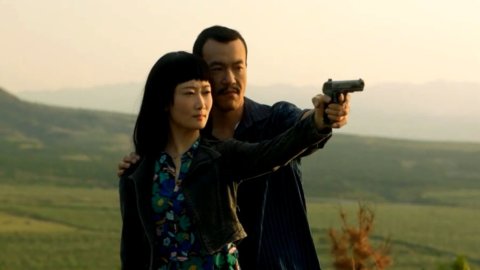Author's judgement: 3/5
China is much closer than we can imagine and the film we are showing this week makes this thought very clear. The story that is told on the screen is that of a man and a woman linked by a complicated love in a criminal environment of honor and respect, not very different from our local mafia or underworld associations. The children of the yellow river directed by Jia Zhangke (he is also screenwriter and producer) is a film that contains several cross stories: the first and most relevant concerns the two protagonists (two excellent actors: Zhao Tao and Liao Fan), their dramatic and contrasted union. The second story, albeit dashed, concerns that typical oriental noir setting where smoky environments, clandestine gambling dens and violence and criminal clans are the main subjects. Finally, the third story, all in images, symbols and icons, concerns modern China which, at least for the writer, appears so similar to the Western world as to arouse a widespread sense of confusion.
As far as the love story is concerned, it is difficult to find an expressive capacity for the feelings as they are represented. Gestures, fleeting contacts, looks and silences that say much more than a thousand words and convey very well the meaning of a complex and difficult love where she reaches levels of intensity that are rare to see, an artist's performance of the highest level. The second trend, that of the so-called jianghu brings us back to images and stories very similar to those to which we have long been accustomed with the various gomorrahs and criminal stories, with the only difference that, in this case, it seems to be in the early days where the clashes between rival gangs still took place with the hands instead of the war machine guns. However, the looks and portraits of the various criminals remain impressed, striking for their apparent simplicity.
This consideration then leads us to the heart of the third level of the cinematographic story: the images of a country by now in many respects almost completely westernized: from the evocation of a well-known luxury car as a myth to the YMCA wild dance of the Village people, to the cap with the advertisement of a well-known off-road vehicle with a precious French-branded lighter and all seasoned with sequences with cell phones that seem to be taken verbatim from our daily lives. We see a China very similar to our world that surprises and amazes those who still imagine it as a powerful country but still, in many respects, backward and pre-industrial. Finally, the yellow river, the Huang He, one of the longest in the world, considered the cradle of Chinese civilization which stands out at the bottom of a story that sees the slow but inexorable flow of its waters together with the development of his country.
Director Jia Zhangke has presented this film last year in Cannes, where he had won an award for best screenplay in 2013 and before that, in 2006, he had won the Golden Lion in Venice with Still life which made him known on the international scene. Undoubtedly, he knows the business of cinema and has perfect mastery of the camera and the direction of the actors. Apparently, it is not at all easy to make films in China without first obtaining a sort of "imprimatur" from the competent authorities. Evidently, this film responds to a certain reading, a type of narration of the Asian country that is pleasing to the Beijing government. Ultimately, it is good to always keep this in mind, we are talking about one of the most important political and economic powers in the world where over a billion people live. In this film, even if at times, you can see it very well and you can sense its weight. It largely deserves the acknowledgments it is receiving from critics and the public.





